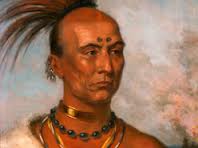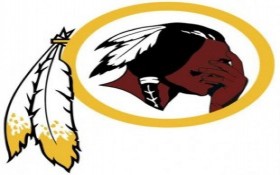Why it’s only right to retire relics like the Redskins
 The recent debate about the Nepean Redskins is getting tired. Frankly, it’s a debate we’ve had over and over again, both in the U.S. and in Canada.
The recent debate about the Nepean Redskins is getting tired. Frankly, it’s a debate we’ve had over and over again, both in the U.S. and in Canada.
Despite the very real fact that the term Redskin is nearly universally understood as offensive, White sports fans loyal to their high school, college or professional sports mascots insist they are ‘honouring’ Us. Prompting Us to write articles and letters, create petitions and polls, and, more recently, use Twitter and Facebook to express our dissatisfaction. And I suspect we’ll continue to do so, so long as football players need savage beasts to emulate on the field. So for our ever-forgetful, sports-loving dogmatists, here’s a refresher on why “I’m not a mascot,” as Simon Moya-Smith puts it.
The last time the mascot issue came up in a serious way was the 2010 Stanley Cup Finals. It was hard to miss the omnipresent headdress-wearing, painted-faced, ancient Indian warrior mascot of the ‘Hawks. I cheered for the Flyers that year (even though as a Leafs fan, I hate the Flyers). And a few years before the Blackhawks yipped and scalped their way to victory, the Cleveland Indians nearly made it to the World Series, inspiring inebriated beer-bellied men to do their best “Chief Wahoo” imitations — “tomahawk chop” and all. Indeed, they became the red-faced and smiling buffoon “Indians.” Of course, to many actual Pottawotami and Delaware people, these fans’ war paint and nylon feathers were embarrassing and humiliating.
While the Cleveland Indians make the Blackhawks look progressive by comparison, both mascots — really, all mascots claiming to honour First Nations or Inuit peoples — do nothing of the sort. It is also puzzling why this “honour” is reserved nearly exclusively for Lakota and Cree peoples. The Redmen or the Braves are so commonplace, there is one in every division. But of course one sees never team names like ‘the Chinamen’ or the Moors who, in very general terms, have just as storied military histories to be “celebrated.” Granted, teams like the Vikings and Fighting Irish do exist, yet they exhibit but a fraction of the scope or absurdity with which “Indian” teams proliferate and are ‘celebrated.’
 And if this is really an honour, should we not expect Blackhawk fans to at least know who Blackhawk actually was? I suspect very, very few actually do. In fact, he was a Sauk leader named Makataimeshekiakiak (right) who vehemently opposed American encroachment into, and annexation of, his people’s lands. So much so, he fought alongside the British to repel the Americans in the War of 1812. But he was captured, imprisoned, and then forced to tour the United States as a demonstration of the new country’s power while White onlookers often burned him in effigy. Is this what the Chicago Blackhawks honour?
And if this is really an honour, should we not expect Blackhawk fans to at least know who Blackhawk actually was? I suspect very, very few actually do. In fact, he was a Sauk leader named Makataimeshekiakiak (right) who vehemently opposed American encroachment into, and annexation of, his people’s lands. So much so, he fought alongside the British to repel the Americans in the War of 1812. But he was captured, imprisoned, and then forced to tour the United States as a demonstration of the new country’s power while White onlookers often burned him in effigy. Is this what the Chicago Blackhawks honour?
But this issue goes well beyond Makataimeshekiakiak and the Blackhawks. Take any Redskin or Indians fan, or, take those of the Nepean Redskins, and ask them what they know about Native peoples outside of the image of the naked, tomahawk-wielding savage of their prized mascot and the response will be a blank stare. So not only is the ‘honour’ a farce, the Indian mascot phenomenon can actually contribute to perception that Native peoples are not actual living people with culture, language, economies, art, politics, and so on. The image traps Indigenous peoples in an archaic and doomed state. As long as Native peoples are depicted as ancient and primitive warriors, they’re not real. They’re relics of a bygone era. They don’t exist in contemporary times (part of the reason we have to deal with the near ubiquitous “Funny, you don’t look Native” comments from Canadians).
Moreover, and particularly problematic, this is an image that been used historically by colonists to justify the slaughter of Native peoples (the savage, ruthless, raping, murderous Indian who circled the wagons and presented a threat to civilization generally). In fact, if it weren’t for the constructed image of the Redskin, Americans would have had difficulty raising militias to fend off the British in the Revolutionary War. Without the image of the Redskin, Andrew Jackson and William Henry Harrison wouldn’t have run for president and won, based on their record of killing Indians. The Redskin trope permitted/permits all manner of horrors against Creek and Comanche peoples because it rendered/renders them inhuman.
Remarkably, the past few years have increasingly seen discussion over the use of Indian mascots. In the United States, the National Collegiate Athletic Association (NCAA) has adopted policies against their use in college sports (the Fighting Sioux being the latest casualty). More recently, here in Canada, the Vancouver Board of Education as well as the Toronto District School Board have voiced their concerns over public and high school Indian mascots. And, of course, there is the renewed campaign to “change the name” of the Nepean Redskins led by Ian Campeau (aka DJ NDN) of A Tribe Called Red, with support from the AFN, TRC, Ottawa Citizen, Leanne Simpson, Pam Palmater, among others. A campaign that has been partially successful. At the time of writing, the President of the Club has told APTN that he’ll take the name change discussion to parents. Whatever that means.
 Critics will continue to cry foul and claim political correctness on the warpath. But this isn’t about misplaced over-sensitivity. It’s about being socially and morally responsible. It’s about respect. It’s about recognizing that there is no such thing as an “Indian” — rather, there are Anishinaabe, Haudenosaunee and Mushkegowuk people — and they don’t wear war paint or throw tomahawks (well, most don’t). They are not savages devoid of humanity, but real people: real, living, breathing people, not caricatures to be trivialized. But the fact that we still have to write articles and letters, create petitions and polls to remind Canadians (and Americans) of these basic facts, year after year, well demonstrates the invisibility sports mascots ultimately confer.
Critics will continue to cry foul and claim political correctness on the warpath. But this isn’t about misplaced over-sensitivity. It’s about being socially and morally responsible. It’s about respect. It’s about recognizing that there is no such thing as an “Indian” — rather, there are Anishinaabe, Haudenosaunee and Mushkegowuk people — and they don’t wear war paint or throw tomahawks (well, most don’t). They are not savages devoid of humanity, but real people: real, living, breathing people, not caricatures to be trivialized. But the fact that we still have to write articles and letters, create petitions and polls to remind Canadians (and Americans) of these basic facts, year after year, well demonstrates the invisibility sports mascots ultimately confer.
[ Bottom image: DJ NDN ]


One thought on “Why it’s only right to retire relics like the Redskins”